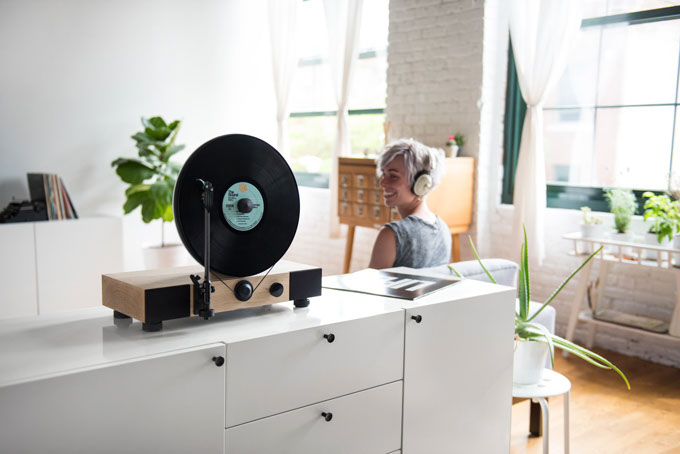Gramovox Floating Record
The Gramovox Floating Record has smashed records and garnered attention worldwide. The program, unlike typical programs we feature only at completion after market introduction or commercialization, is a living, evolving program still in development. Because of this, we are posting a follow up case study here with updates and new technical details. The original case study can still be seen right below this, or by clicking here.
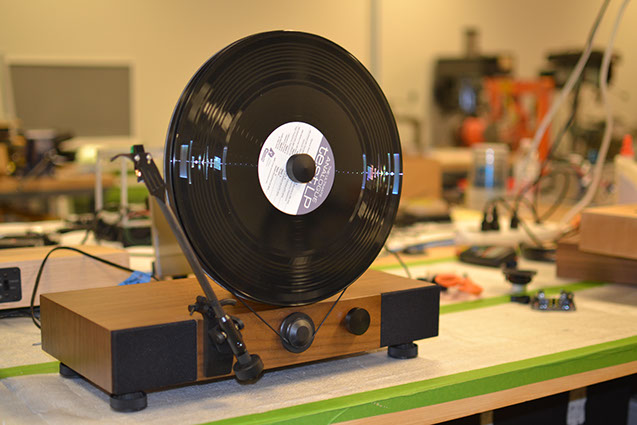
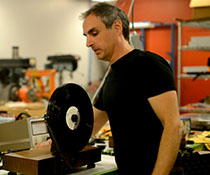
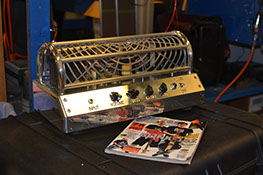
Frank Pistorio, PDT team member of 17 years, has been the lead engineer on this program. He started his career as a certified MoldMaker, moving into tooling engineering, then into prototyping. As master model maker and music fanatic, he has helped lead this program for PDT from the beginning. He has passionately poured his comprehensive understanding of materials, sound, mechanics and more into the development of the Gramovox Vertical Record Player. Frank is no newbie to the audio scene; his own creation, the ‘Alchemyst’ amp – a 30 watt, hand wired, all tube, EL84- powered guitar amplifier- was featured in a January 2004 issue of Guitar World magazine.
Gramovox, based on feedback from numerous cabinet manufacturers with decades of wood crafting experience in hand, approached PDT with a shift in project specifications. The Floating Record was to change from a solid wood base to MDF for long term structural stability reasons and to ensure consistency in manufacturing. This decision was a big one for Gramovox given the investments made in the original direction. As can be seen in the prototype case study below, a lot of research and development went into engineering them to function properly.
PDT was to make additional prototypes incorporating the new MDF bases, using the existing solid wood prototypes as benchmarks for turntable and audio performance. With MDF being incorporated in the base design, quelling any long term structural integrity concerns, the goal now was to do whatever was necessary to make the new MDF prototypes perform and
sound as good as the original solid wood prototypes.
All that was learned and applied to the original solid wood prototypes was carried over to the MDF prototypes, every aspect being identical with the exception of the MDF base.
Performance metrics were gathered through empirical testing of the first MDF prototype, and, in this application, the MDF base outperformed the solid wood bases. The performance is, in fact, enhanced due to the physical properties of the MDF. No additional changes were required to exceed the benchmark standards.
tuning. It turned out that the unit was able to be played at full volume without any of the tuning/counter weights installed into the base.”
The steel weights are still being incorporated into the rear of the new MDF bases, but their sole purpose now is to add mass and offset the front end weight from the heavy Acrylic platter and plinth.
Additional weight in a turntable is always a plus, as more mass helps make the unit less susceptible to vibration and resonance. Our MDF prototypes are currently just over 14lbs each.
2) The wood prototype case study also mentions that 2” speakers can sound a bit bright and boxy, especially when installed into a cabinet which was cored from solid maple. Later in the development process, when we were confidant we were getting the best audio we could out of the solid wood bases with our component selection and construction alone, we moved onto voicing the amplifier to address the small bit of boxy, brightness inherent to the small speakers. We ending up cutting the 1k frequency band by about -4db.*
When we assembled the first MDF proto, this EQ notch was left out, again to establish a new baseline, but this time regarding audio. It turned out that the new mdf base did not require the small cut at 1k, no EQ was required.*
Says Pistorio, “not only were the mids, upper mids and highs audibly smoother, but the bass response was also improved, extending deeper than the solid wood prototypes.”*
*The solid wood protos E.Q. was after the phono stage, at the power amp input stage. Our phono preamp incorporates the standard RIAA equalization curve only. The line out signal comes directly from the phono preamp.
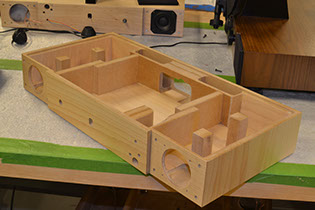
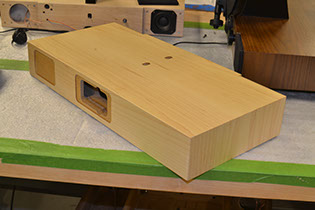
“There are two things I would like to point out that I feel highlight the performance advantages the MDF had over the solid wood bases in our prototypes,” says Pistorio.
1) The wood prototype case study covers what was required for us to tune the resonant frequencies of the solid wood boxes, and in the case of the base itself, we needed to add metal counterweights. In the end we were able to locate them at the rear of the box and also add additional weight, more than what was just required for tuning. The additional weight was to balance the unit as a whole, offsetting the weight placed on the front by the heavy platter and Plinth.
When we assembled the first MDF proto, the steel weights were left out. This was done to establish a new baseline for the MDF, regarding resonance. “But,” says Pistorio, “I was also curious to see just how good the MDF was at dampening resonance on its own, without any
Not All MDF is Created Equal
MDF has earned a bad reputation as cheap junk, the stuff cheap furniture is made from. But not all MDF is created equal. The MDF Gramovox will be leveraging is far different and in no way resembles what is found in lower end furniture. In fact, it is the same product used and trusted in some of the most expensive speakers made by the most reputable brands around. Examples of this would be my two favorite box speaker manufacturers KLIPSCH and B&W.
The MDF in the Floating record meets impressive screw hold test specifications:
Face Screw Hold > .375" (9.5mm) 300 LBf
Edge Screw Hold > .025" (16mm) 275 LBf
Density ( < .551") 49.0 lbs/ft3
Density ( > .551") 48.5 lbs/ft3
COSMETIC DURABILITY
Sometimes people worry about veneer degrading over time. Frank calls attention to his personal vintage Hi-Fi system, which consists of:
- 2 Marantz Imperial 6 Speakers. Made with MDF and veneer. Circa very early 70’s
- Sansui 4000 Stereo receiver. In original wood case, made with MDF and Veneer. Circa, very early 70’s
- Bang & Olufsen Beogram 4004 turntable, with original stylus. (1979)
The veneer on these components still looks very attractive after all these years and their vintage value is on the upswing. “This system was handed down to me and I will hand it down to my kids,” says Pistorio.
Adjustability
The unit has been designed to be fully adjustable/tweakable, which is the way all great turntables are designed. Here is a list of adjustments:
1) Azimuth
2) Cartridge angle
3) Cartridge Vertical tracking angle, via the adjustable plinth, or shimming the tone arm base.
4) Cartridge Tracking Force.
5) Tone arm height, via the adjustable plinth, or shimming the tonearm base.
6) Radial balance, via the tone arm counterweight.
To a true Hi-Fi enthusiast with turntable experience, these adjustments are of utmost importance and most are expected to be found in any decent turntable. Having this adjustability built in allows the seasoned user to customize to their liking, a good example would be installing their preferred phono cartridge.
As the technologies, features and details of the Floating Record aside from the new base are all unchanged, we invite you to read the original case study below for more about the project.
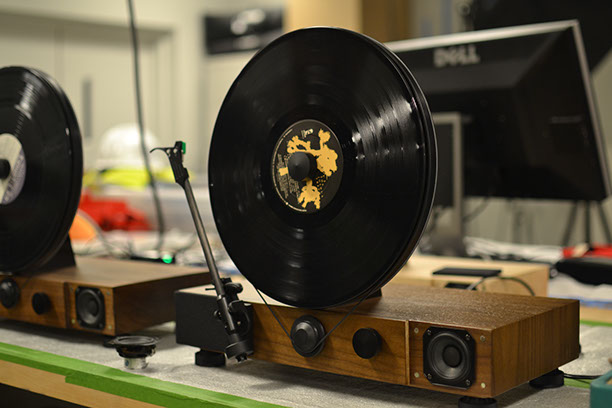
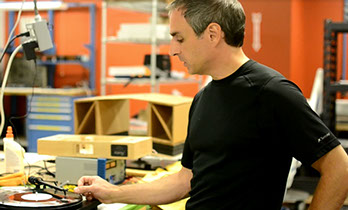
About Frank Pistorio, PDT Engineer
In his role at PDT, Frank has been a part of hundreds of projects that span consumer electronics, appliances and recreational goods, medical and surgical devices. Frank also has expertise and a passion for SCCA road racing, XC mountain bike racing, Vintage sports car restoration, tube guitar amps, vintage hi-fi, vinyl and photography.
“As for my audiophile system,” Frank says, “It consists of 2 Magnapan 1.6 speakers, Bryston 4BST amplifier, Myryad MP100 Preamp, Arcam Alpha7SE CD player, various Techniques turntables run with Shure M97XE cartridges and Transparent Audio speaker cables and interconnects. “This system, which I assembled around 2000, is my point of reference for what I consider great sound.”
Frank has applied his knowledge of complex mechanical assemblies and the relationship between form and function to offer efficient and cost-effective solutions in a mechanically challenging prototyping environment. He found the Gramovox project particularly thrilling given his personal and professional experiences and passions.
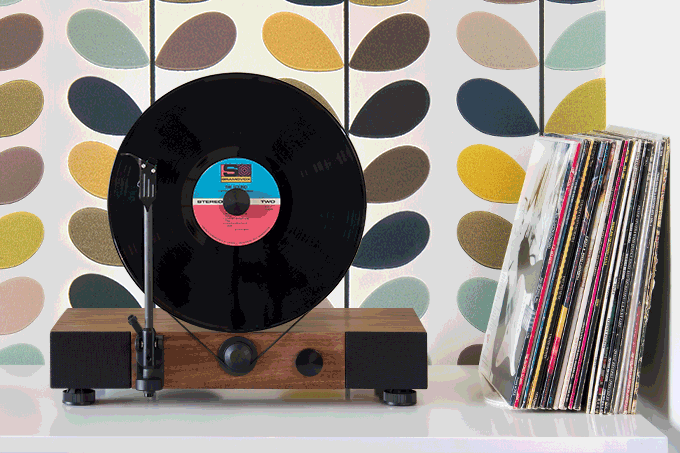
Gramovox Floating Record
The Gramovox design philosophy is to reimagine vintage audio design with modern technology. After a successful Kickstarter campaign for their Bluetooth Gramophone, they sought to showcase the record as both art and a medium to produce analog sound. Gramovox, a fellow member of 1871 in Chicago, sought PDT's help in bringing this high-performance turntable that plays records vertically to fruition and it's now on Kickstarter, funded in less than 3 hours!
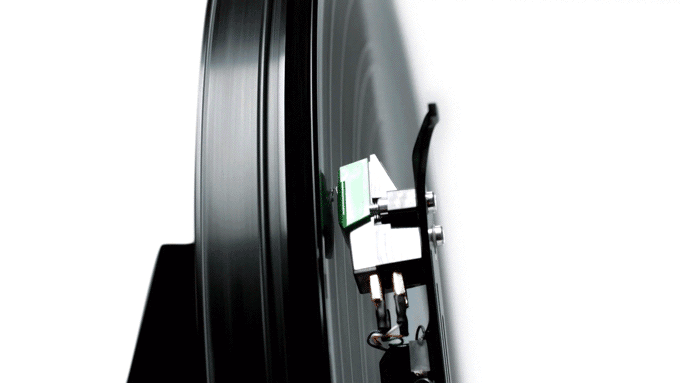
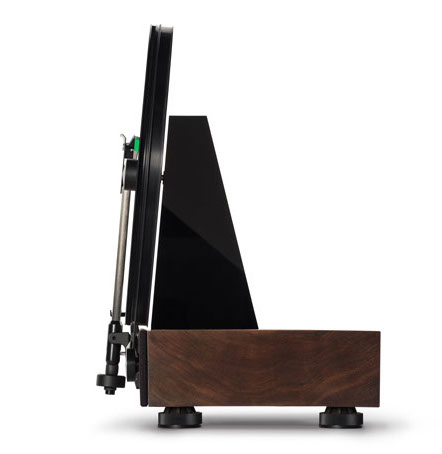
THE TASK
Traditional record players occupy a large footprint and require additional components such as pre-amps, amps, integrated receivers, speakers and all the necessary cables. We would like our Floating Record designed in a way that allows it to fit into most environments with ease, utilizing integrated components and play in a vertical format.
WHAT PDT DID
We've engineered the Floating Record to flawlessly play vinyl vertically and output full-range sound. We deconstructed the elements of a premium turntable setup and reconstructed them in a manner that maintains their high-performance standards.
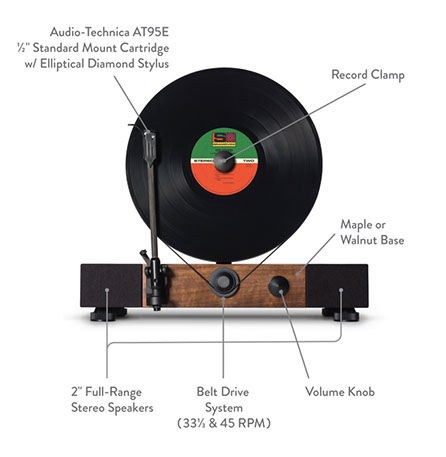
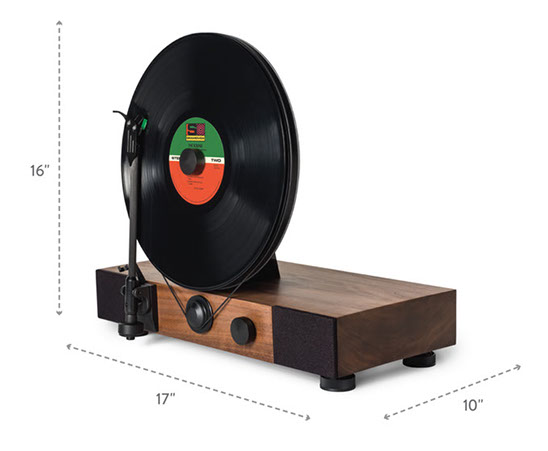
Prototype Conception
It all started with an emphasis on design to evoke simplicity and elegance, while being intuitive to the user. The twist on convention was that it had to play in a vertical format…And….. It had to have built in speakers and amps…And…. It had to sound good.
And herein lie the two biggest challenges:
1. How do you get the tonearm to play vertically without flopping from one side or the other? The stylus needs to track the groove on center without favoring one groove wall over the other. The grooves in a record have a right and left side, right side, right channel, left side, left channel. If the stylus favors one side over the other playback will be skewed to the favored side, and audio reproduction will suffer.
2. How do you get the onboard speakers to play at a reasonable volume without affecting the phono cartridge and creating a feedback loop? The cartridge's diamond Stylus is mounted to a cantilever that carries a tiny permanent magnet, which is positioned between two sets of fixed coils inside the cartridge, forming a tiny electromagnetic generator. The diamond stylus rides in the record groove, tracking the modulations. These modulations vibrate the cantilever magnet which induces a tiny current in the coils. This current (your music) is sent to the phono pre-amp to be amplified.
The record groove modulations are tiny, to 4 decimal places tiny. And anything that causes that cantilever to move even by .0001 is going to create a signal… well now we have onboard speakers, causing vibrations to the wood base, which the tonearm and platter are directly mounted to…..Not Good… And to top it off, those vibrations are being created by what the cartridge is sending to the amp to be sent to the speakers…..even more Not Good….. This is like having a microphone hooked up to a PA system and then pointing the mic right at the PA speakers.
Challenge 1: Find Balance
Here is the tonearm assembly mounted to a test fixture being balanced radially around its main pivot axis. Basically, you can take the arm and rotate it 360 degrees, and anywhere in that rotation you could let go and the arm will stay put: from balance, not friction.
Balancing is achieved by sliding the round counterweight along its shaft axis, changing the distance from the tone arms main pivot. In a conventional record player, that counter weight is used to set tracking force. However, in our vertical format, we made modifications that would allow it to be used to balance the arm radially.
In order to perfectly balance the tonearm radially around its main pivot bearing axis, we had to get every detail right within incredibly tight constraints, which we did.
Which brings up the next issue, setting tracking force.
"May the force be with you."
OBI-WAN KENOBI
Tracking force is the downward pressure applied the cartridge stylus so it can track the record groove modulations without jumping out of the groove...
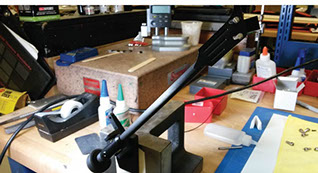
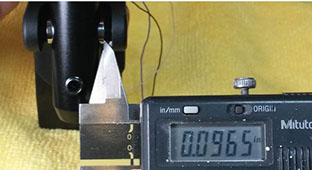
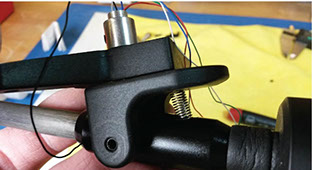
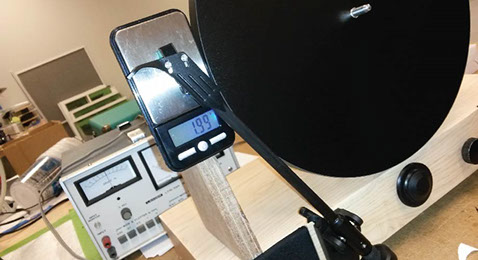
Our tonearm assembly incorporates a spring in the base of the tone arm to apply tracking force.
Left is a picture showing the tracking force being set on a vertically mounted digital scale. The tracking force is fully adjustable with a range that allows any cartridge to be used and set to the manufactures recommended setting.
The tracking force is dynamically applied by a spring as opposed to the usual counterweights found in horizontal record players in which the arm is statically balanced. Spring loaded tracking force is beneficial in regards to consistency of the force applied, especially on warped records. Plus, it allows our record player to track the grooves vertically.
Challenge 2: Find Isolation...In a good way.
We worked out getting the tonearm to function correctly in a vertical format, now we had to get the whole assembly to play records without feeding back. This required a mix of techniques, such as isolation, damping, and shifting resonant frequencies.
We did this mostly through construction methods and material selection. From the beginning, we knew we were going to need to add mass to the assembly. So we choose to make the platter and plinth out of acrylic for its high mass and low resonance characteristics. We also decided to go with carbon fiber for the tone arm shaft due to its low weight, stiffness and resonance damping attributes.
The platter is belt driven and that helps to isolate any small motor anomalies from the platter. The motor is also isolated from its mount with rubber bushings.
This worked well enough to get a fully assembled prototype together and functioning.
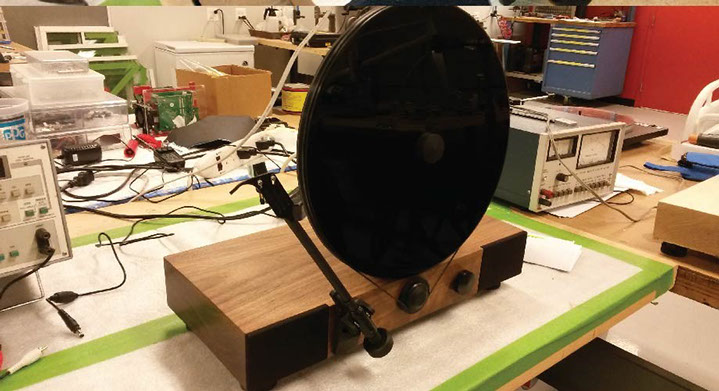
Fine Tuning Mechanicals
Next was the fine tuning phase to get the record player assembly to play at higher volume levels without feeding back. We discovered there were three components contributing to the feedback issue.
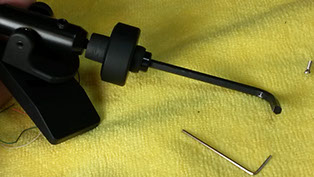
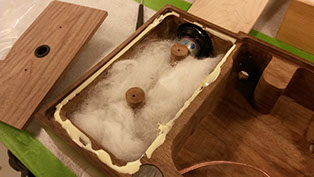
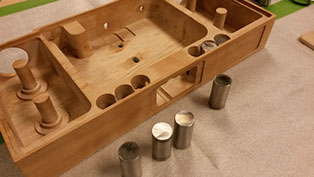
First
The counterweight needed to be isolated from the tonearm. We did this by using a Poron sleeve between the weight and its mounting shaft.
Second
The tops and bottoms of the speaker cavity were vibrating; basically, the speaker cavity was acting like a diaphragm. We added internal posts to couple the tops and bottoms together to make a nice, rigid box. The speaker cavity cover was glued and screwed in place.
That white material is poly fill to help control any internal resonance. And that round plastic port on the cover is tuned to the speaker and cavity volume to help get more bass output. The speaker cavities are tuned to extend down to 110hz with the addition of the ½” dia x 1” long port.
Third
We needed to tune the resonant frequency of the wood base to a point where it was no longer interacting with the tonearm assembly. We achieved this by carefully adding weights to specific locations while the player was at max volume. We settled on Six 1”dia x 2” long steel weights placed at the rear of the unit.
At this point, we had our record player playing at max volume without any resonance or feedback issues.
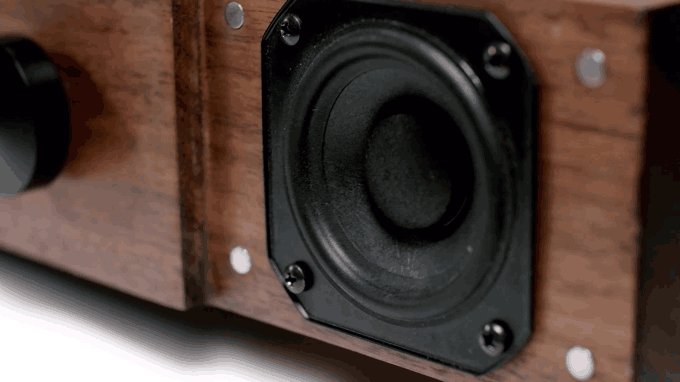
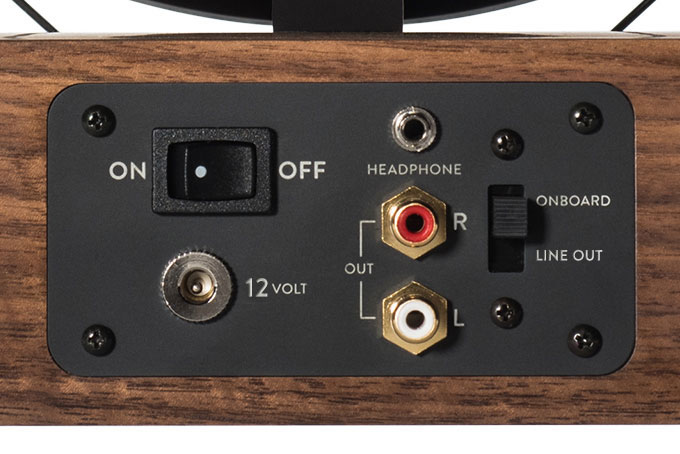
Tweaking the Audio
With these major hurdles out of the way, we were able to move on to getting it to sound as good as possible. This was achieved through careful component selection with an emphasis on choosing parts that would complement each other.
The major limiting factors were the 2” speakers and .03cf of space available for each speaker cavity volume.
We tested several pairs of speakers from various manufacturers. Speaker selection was based on frequency response, required cavity volume, sensitivity, power handling and voicing. We choose speakers that would give us the largest frequency response, handle our power needs, work in our small space and still sound good. Low end extension was of prime importance; we needed to get the most bass available in a 2” speaker without the help of a subwoofer or passive radiator and decent highs without using tweeters and crossovers.
Oh, and we had to do this as cost effectively as possible to keep the BOM costs down.
Since 2” speakers can sound a little bright and boxy, we choose a cartridge and phono preamp circuit that would work together to create a warmer and smoother sound.
We also tried a bunch of digital power amps circuits and chose the one that had the warmest and most analog sound to it.
We settled on a cartridge, preamp and amp combination that got the best out of our selected 2” speakers.
"If it sounds good, it IS good."
Duke Ellington
At this point we were sounding pretty good, and who could argue with Duke.
Time to add some user features
We created the option of bypassing the internal amp and speakers and outputting an RIAA equalized line level signal from the built in phono-pre via the "Line Out" RCA jacks. The switch is used to choose between Onboard and Line Out.
Standalone Hi-Fi Turntable and use with Headphones
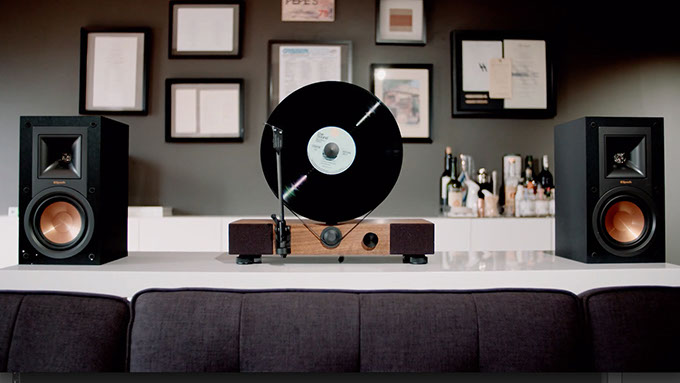
The onboard position activates the built-in phono stage--the 15 watt digital power amp and built-in speakers. The “Line Out” bypasses the internal amplifier and speakers, and takes the signal from our built-in phono-pre to the “Line Out” RCA jacks. This allows the player to be used as a standalone Hi-Fi turntable. RCA out is a line level signal that is used to connect to an existing stereo system via the “Tape in” or “Aux In” inputs on your receiver, pre-amp or amp.


